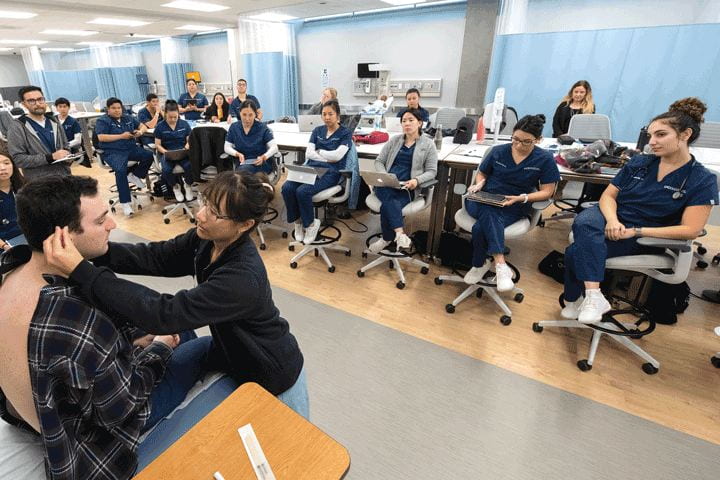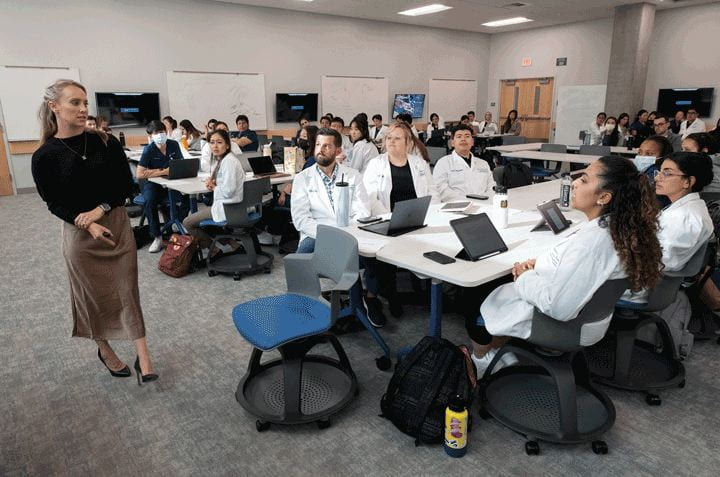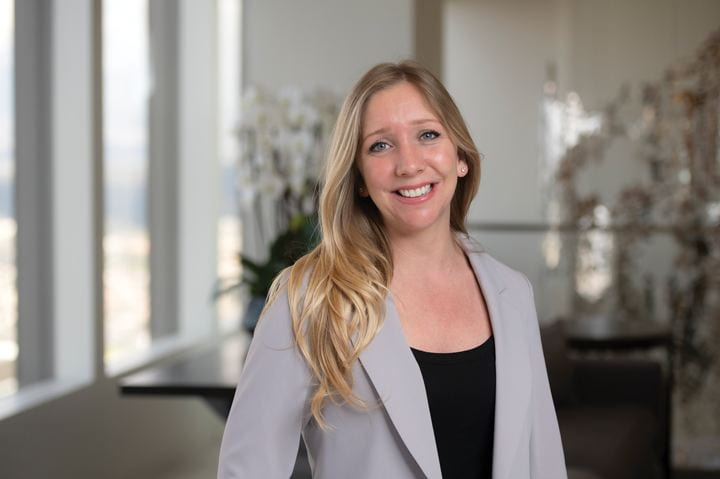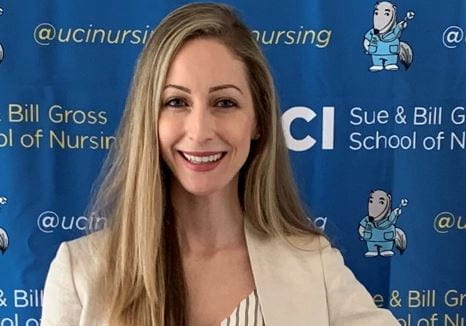
Learning With and From Each Other
New high-fidelity simulation classroom serves as a hub for interprofessional education among healthcare students
Anu Light – playing the patient in a mock scenario – wears makeup so that her cheeks appear flushed, slurs some of her speech and plays up her disheveled hair and clothes. The first-year student in UCI’s master’s entry program in nursing even has a mouthwash she’s used to simulate a boozy smell.
Puppet master – or rather patient master – Viviana Garnica, also a first-year MEPN student, beams. “Oh, it’s working so well,” she says. “I wrote this patient scenario. I wanted it to be something complex, something that actually happens in the ER.” Her patient, played by Light, is experiencing an assortment of health problems – and is also intoxicated – which gives her fellow nursing students plenty to grapple with as they try to do a physical assessment on their patient. “The beauty of this is that it feels real, and that makes it all more memorable and important,” Garnica says.
Nearby, other students practice physical assessments: asking questions and following a careful routine of examining the patient, using each other or medical mannequins so authentic that the skin on the hands feels crepey, like an elderly patient’s skin might.

They’re in the newly opened simulation center classroom in the Sue & Bill Gross Nursing & Health Sciences Hall. Farther down the corridor, where “high-fidelity” simulation takes place, things get even more real: spaces are nearly identical to hospital intensive care units, patient rooms, birthing rooms, and rehabilitation or nursing home facilities. They stand ready for pharmacy, medical and nursing students to work together on scenarios scripted by instructors Stephanie Au, assistant clinical professor of nursing, and Cheryl Wisseh, assistant clinical professor of clinical pharmacy practice. In the high-fidelity section, all is controlled by simulation technician Tommie Olds, who, in collaboration with the instructors, alters the information the students receive on the medical equipment and the mannequin vitals based on what students decide to do or don’t do – for example, hook up an oximeter or administer a certain dose of medication.
Later in the afternoon, across the Susan & Henry Samueli College of Health Sciences building foyer in Room 1020 – an extra-large learning space built for collaboration with flexible seating arrangements, whiteboards and projection capabilities at all the stations – nursing students wearing dark blue scrubs join pharmacy students sporting white coats. Numbering about 75, they’re there for a multi-hour class led by Wisseh and facilitated by a team of instructors from the School of Nursing and the School of Pharmacy & Pharmaceutical Sciences.
A National Movement

This is all part of a growing wave in health sciences instruction called interprofessional education. While it’s still relatively new at many institutions, UCI has been among the trailblazers. As early as 2014, medical and nursing students started joining forces in the School of Medicine’s Medical Education Simulation Center to train primarily on emergency scenarios. The last two years they’ve also expanded to other clinical situations. The School of Medicine’s IPE is headed up by Dr. Cameron Ricks, professor of anesthesiology, and Dr. Alisa Wray, associate professor of clinical emergency medicine.
Now, with the recently opened sim lab in the School of Nursing, there will be additional opportunities for interprofessional training and more students will get IPE earlier in their education.
“Interprofessional education means that healthcare professionals learn with and from each other in a variety of collaborative formats,” explains Au, who wrote her doctoral dissertation on IPE. “Students get to interact through discussion, case studies, simulation exercises and peer teaching. IPE presents this whole assortment of various collaborative, team-based exercises so students from different health sciences come together to figure out problems. Here at UCI and nationwide, IPE is being recognized as essential.”

There’s a peer-reviewed Journal of Interprofessional Education & Practice and a national consortium of educators called the Interprofessional Education Collaborative, both of which support the IPE effort. The American Association of Colleges of Nursing, the National Academy of Medicine and the National League for Nursing have prioritized interprofessional collaboration as a crucial component of education necessary to improve the quality of healthcare in the United States. Over in UCI’s Program in Public Health, researchers are also parsing IPE outcomes.
Research such as that published in the peer-reviewed publications BMC Medical Education and American Journal of Pharmaceutical Education suggests that interprofessional education can improve the performance of medical, pharmacy and nursing students on both basic job tasks and those that present life-or-death emergencies, as well as make students more engaged and valuable team players. At UCI, there are two newly formed committees exploring myriad ways to best implement and expand IPE; Wisseh is chair of one, and Au is co-chair of the other.
Au acknowledges all the benefits of IPE, including creating a caregiver mindset of collaborative, patient-centered care, and adds: “Besides, students always tell me that they just simply enjoy learning this way. It’s fun – and they get a lot out of it.”
Developing Collegiality
It’s growing late on this Tuesday afternoon, but the large group of pharmacy and nursing students pull out laptops and iPads, eager to dive into their collaborative work. From the front of the classroom, Wisseh explains the mock scenario to a dozen tables of students, a sea of white coats and blue scrubs.
Nursing instructor Ryan Batten glides his rolling chair between two tables in the back, enthusiastically encouraging the students to speak up. “They’re usually shy at first, but they warm up quickly. The whole point is to get them comfortable working with other health professionals right now,” he says. The white coats outnumber the blue scrubs today, but in Batten’s experience, nursing students tend to be more naturally extroverted. “Yet the pharmacy students always rise to the occasion once they warm up,” he says.
First-year Pharm.D. student Prerana A. Reddy ponders the medical scenario Wisseh has detailed, including a list of medications the mock patient supposedly takes. She muses about possible drug interactions and then shyly comments, “And the patient is uninsured. She’s been cutting back on insulin. It could be the cost.”
First-year MEPN student Rose Hawaree zeroes in on one of the vitals. “A-fib?” she asks. Batten nods approvingly.
Across the room, former mock patient Light suggests a possible stroke. She discusses her idea with several pharmacy students. “Ischemic or hemorrhagic?” Light asks.
“Well, we don’t know,” another student says. “We can’t know yet.”
Wisseh calls on a few students, some nursing and some pharmacy, to share their opinions. Then she presents a question for the whole room. A few nursing students shoot back answers referencing something tricky about the patient’s heart rate. From the dais, Wisseh says, “Hey, it’s OK, pharm students. You haven’t learned about that yet!”
Hawaree says she’s sold on IPE: “This is the type of learning that we could never have in a regular nursing class. We get a firsthand experience of the different roles in the healthcare setting, and we get to bounce off ideas. We also get more insight into the different expertise each professional brings to the table.”
First-year Pharm.D. student Sara Sarpas agrees. “It’s incredible to have this experience early on,” she says. “We pharmacy students need to be exposed to how nurses and other health professionals think. This is important for us being able to eventually work together as a team. One day we’re going to be treating patients, and we need to be on the same page.”
“When you’re in a simulation lab or working through a mock scenario with other health professionals – or in a real clinical setting – things are much less black and white. It’s about offering up ideas and checking them out. That’s something we want them to get used to. It might be uncomfortable for some of them, but it’s necessary.”
– Stephanie Au, assistant clinical professor of nursing
Precisely, says Farah Khorassani, associate clinical professor of clinical pharmacy practice. She circles her tables of students near the front of the room, monitoring their progress and making sure they’re sharing everything they know. “It’s really an incredible program here,” says Khorassani, who came to UCI from St. John’s University and Bellevue Hospital in New York City in September. “IPE is growing in importance everywhere. The folks who credential or license various healthcare professionals are more and more requiring this type of education. But UCI is definitely getting students involved in IPE quicker and to a greater extent than many schools.” She reminds her group that today’s exercise is more about discussing than getting the right answer.
Indeed, the work isn’t even graded; students receive credit for participating. Instructors primarily want them to feel uninhibited, be eager to share and even make mistakes.
“We know these students are incredible or they wouldn’t be here at UCI,” Au says. “Very often they’re the type who are used to something having a right answer and a wrong answer. That’s usually how it works in a typical classroom. But when you’re in a simulation lab or working through a mock scenario with other health professionals – or in a real clinical setting – things are much less black and white. It’s about offering up ideas and checking them out. That’s something we want them to get used to. It might be uncomfortable for some of them, but it’s necessary.”
Preventing Safety Issues
Of course, the state-of-the-art simulation facilities, high-tech mannequins and collaborative classrooms at the new Susan & Henry Samueli College of Health Sciences building facilitate IPE. Even the fact that the College of Health Sciences, the Susan Samueli Integrative Health Institute and the Sue & Bill Gross School of Nursing physically adjoin encourages everyone to learn together, Au says.
But despite a strong desire to break down silos, co-location, hotrod facilities and all the tech in the world, coordinating large groups of students from different programs is never easy. “There’s a common saying that IPE eats logistics for lunch, and I think that’s very true,” Wisseh says.
In her office, Jocelyn Ludlow, director of the simulation lab, waves her hand at a whiteboard with so many arrows and slashes that it looks like she’s scribbling plays for a football team. But she’s merely figuring out IPE simulation lab scheduling issues. “It’s so tough to get schedules to match up, but we’re determined,” Ludlow says. “The whole school is behind IPE – the deans of the different schools, the instructors, everyone.”
Why so much dedication? She says that IPE has the power to change the professional landscape of healthcare. Training students together very early on and fostering their understanding and respect of each health professional’s role is the best strategy for eventually breaking down toxic hierarchies in medicine.
“Lack of communication is the No. 1 cause of most safety issues in the healthcare setting,” Ludlow says. “Why does a lot of that miscommunication happen? Too often it’s because certain healthcare professionals defer to the other professionals; they don’t believe they can or should speak up. We need to change that. The goal here today is better education, but the end goal is always better patient care.”
Au seconds that. “I think of interprofessional education as the sort of training that teaches all the different healthcare professionals that they deserve a seat at the table,” she says. “We’re teaching each health professional to recognize and value the other health professionals’ contribution, to be able to work as a team because, truly, medicine today is a team sport. These students will graduate and will often need to be able to work as part of a large and very complex healthcare team. We are determined here at UCI to make sure our students are trained this way from the start and prepared for their future.”


